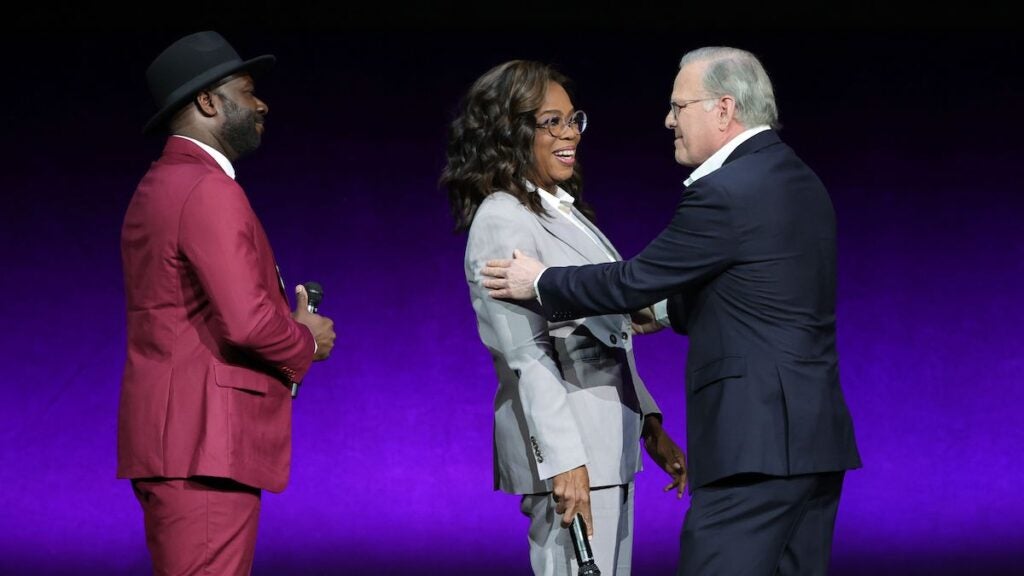
CinemaCon Takeaways: Theatrical Movies are Back
Studios are filling the theater pipeline again in 2023, and now it’s up to audiences to show up
David Zaslav himself, the CEO of Warner Bros. Discovery, made the pilgrimage to Vegas to underscore his commitment to making movies for theaters — on the heels of strangling HBO Max in its crib in favor of just plain “Max.”

“Courage — it’s one word we all share,” he said in an emotional address to the room of 3,000 theater owners. “We’ve got to rally right now. People need to escape, to be inspired.”
Moviegoing, he said, “can be bigger and stronger than it has ever been.” He added: “We’re all in.”
Or as Sony Pictures chief Tom Rothman put it more mordantly: “For the past three years, as the punditocracy pissed on your business, we at Sony held fast. We are the only studio that held entirely to theatrical… Well, whaddaya know?” (Sony doesn’t have a streaming service to pivot to, but never mind.)
The Warner Bros. presentation hammered the point a little harder than it needed to, with what amounted to four and a half hours of movie presentation (including an intro from the National Association of Theatre Owners), which featured teasers of a gorgeous “Wonka” starring Timothée Chalamet and a peek at Greta Gerwig’s clever “Barbie.”
But the message resonated across all four days of the convention, with everyone from Sony’s Rothman to Paramount’s Brian Robbins to NATO’s outgoing chief John Fithian (“incredibly bullish,” he stated) and even Martin Scorsese emerging as the leading cheerleaders for theatrical releasing.
Here are the facts, though: Domestic U.S. box office in 2022 brought in $7.3 billion for the industry, still 35% behind where it was in 2019 before the pandemic. No one I spoke to wanted to commit to whether the box office will hit that bar of where it was four years ago, $11.4 billion — which would only represent returning to pre-pandemic par, not actual progress.
So, even with the enthusiasm so palpable at CinemaCon, the unease beneath it is really clear.
Here are my takeaways.
Will audiences show up for mid-range movies?
If 2022 proved definitively that audiences would show up for tentpoles like “Top Gun: Maverick” and “Avatar: The Way of Water,” and horror like “M3GAN” and “Smile,” this year will test the proposition beyond that. Will audiences come back to the cineplex for all the other kinds of movies: comedies, animation, dramas and rom-coms?
Everyone will go see “Indiana Jones and the Dial of Destiny,” and they might even see it more than once. But the studio presentations featured movies across the range of genres (with one notable exception, see below for that) including feel-good family fare like “The Little Mermaid”; tons of animation (Pixar’s “Elements,” Illumination’s new “Trolls”); lots and lots of horror (more “Conjuring,” a new “Exorcist”); R-rated comedy in Lionsgate’s “Joy Ride” and Sony’s Jennifer Lawrence sex romp “No Hard Feelings.” Also: fantasy, action, superhero adventures, a musical “Color Purple” that will appeal to musical lovers and Black audiences and a “Bob Marley” biopic coming from Paramount.
But it remains to be seen whether audiences will get off their couches and abandon streaming to see smaller movies that don’t absolutely need to be seen on the big screen. What Hollywood and exhibitors really need is for the moviegoing habit — already in decline before the pandemic — to be reignited by a consumer audience eager to get out of their houses and experience entertainment with a group of strangers. It’s possible. It’s just not that likely.
How much box-office revenue is needed to sustain the exhibition ecosystem?
That’s a billion-dollar question. Projections for 2023 box office range anywhere from $9 billion-$10 billion, which still puts it below 2019. The head of the largest theater chain in America, AMC CEO Adam Aron, said in an interview with TheWrap he’s “reasonably confident” his company is “out of the woods,” but affirmed that “we need more movies,” noting that it’s probably two more years before the box office reaches pre-pandemic levels.
Paramount president of distribution Chris Aronson (who showed up in a “Power Rangers” outfit, nice one, Chris) gave a hard truth to the room, which he can get away with: “2022 made us fall in love with going to the movies again,” he said. But attendance was going down and prices going up even before the pandemic. “Admitting the status quo” is key, he said. “We’ve got to change it… Make the audience offers they can’t refuse.” By which he meant offer variable pricing so that not every movie ticket costs the same, an experiment he tried for “80 for Brady,” successfully.
But his boss Marc Weinstock, head of Paramount’s global distribution and marketing, put it more broadly: “Our job is to create FOMO, and to make people feel like they have to go to see a movie right now.” That really is the challenge.
What’s the problem with dramas?
The one category that seems to be really struggling are adult dramas. They have all but disappeared from the screen along with, let’s just say it, sex. I don’t recall seeing one single sexy scene in four days of trailers and teasers. Hollywood is afraid of sex. That’s pretty clear, with the #MeToo of it all, the lack of clarity around gender roles, the rise of intimacy coordinators, with executives and directors getting accused of harassment and with who is on top and who is allowed to be on top. Cis sex is definitely OUT. Even flirting is out. That’s a shame. (“Joy Ride,” a comedy, has a close-up view of female genitalia that is intended for shock value and is anything but sexy.)
But the track record for even non-sexy dramas featuring adult human actors isn’t great. “She Said” was a bomb at $6 million U.S. box office; “Banshees of Inisherin” made only $10.6 million in the U.S. and $50 million worldwide despite its award nominations and wins. Even Steven Spielberg’s childhood reverie “The Fabelmans” made only $45 million worldwide and a pale $17 million domestically.
There were almost no major studio releases in this category shown at CinemaCon. One Disney movie that qualified, a feel-good soccer movie starring Michael Fassbender, “Next Goal Wins,” felt like it would be a strong candidate for Disney+. It seems that Sony is seeking to take the spot of producing R-rated fare for theaters, and had two films that might qualify: Jennifer Lawrence’s sex romp “No Hard Feelings” and the Glen Powell/Sydney Sweeney rom-com “Anyone But You.”
The rest was rated R for violence, not sex: Ridley Scott and Joaquin Phoenix’s battle epic “Napoleon,” Denzel Washington’s red-band trailer for “The Equalizer 3” and the promise of more “Bad Boys” movies. Even Sony’s big superhero announcement was that Aaron Taylor Johnson’s “Kraven the Hunter” would be an R-rated gorefest, as evidenced by the blood-soaked teaser.
Note to Hollywood: if you want adults to go back to the theater, you’ll need to make some of those must-see experiences with human actors, projecting feelings other than terror and pain.
As Zaslav put it: “This is our time. What stories are we going to tell? And what impact did that have?”



